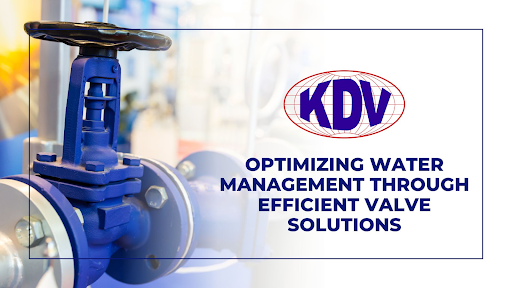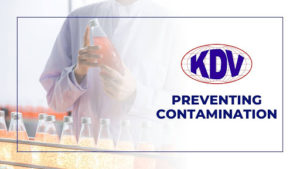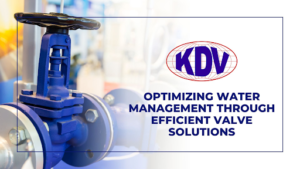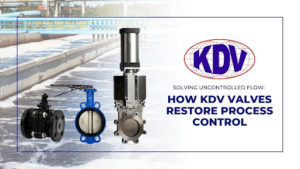Optimizing Water Management Through Efficient Valve Solutions
Water scarcity is a growing global concern, with far-reaching consequences for industries, agriculture, and communities. Responsible water management is no longer optional—it’s a necessity. Effective solutions are needed to conserve this precious resource, optimize its use, and minimise waste. A study published in Australia State of the Environment highlights that “Several indicators have been developed over the past few decades to assess the relationship between water availability and water use”. KDV Valves, a leading provider of high-quality valves, offers innovative solutions to address these critical challenges.

The Problem: Water Scarcity and Inefficient Management
The scarcity of fresh water is intensifying due to population growth, climate change, and unsustainable consumption patterns. In agriculture, inefficient irrigation practices can lead to water waste and overuse. In industrial settings, leaks, outdated equipment, and poor process controls can result in significant water losses. Moreover, industries relying heavily on water, such as energy production and chemical processing, face increasing regulatory pressures to improve efficiency and reduce consumption. Even municipal water systems face challenges with aging infrastructure and managing demand fluctuations. This makes the adoption of innovative solutions crucial in maintaining water security and operational sustainability.
Even municipal water systems face challenges with aging infrastructure and managing demand fluctuations.
How KDV Valves Can Be a Solution
KDV Valves provides a comprehensive range of valves that play a pivotal role in optimizing water management across various applications. By leveraging advanced engineering and precision manufacturing, KDV ensures that its valves meet the highest performance standards across multiple industries.
Precise Control for Different Processes:
KDV Valves are designed to offer precise control over water flow, allowing for tailored solutions in diverse scenarios:
Agriculture: KDV valves are essential for modern irrigation systems, enabling efficient water delivery through drip irrigation, sprinklers, or center pivots. These solutions enhance water conservation by preventing runoff and ensuring targeted hydration to crops. Additionally, they facilitate precise fertigation (the application of fertilizers through the irrigation system) and maintain optimal water levels in greenhouses. This improves crop yield while minimising water wastage.
Industrial Processes: In industries like manufacturing, food processing, and mining, KDV valves ensure accurate water flow control for cleaning, washing, cooling, and other critical processes. By integrating automation with KDV valve solutions, industries can enhance process efficiency and reduce operational costs.
Municipal Water Systems: KDV valves play a crucial role in managing water distribution networks, maintaining consistent pressure, preventing leaks, and ensuring the reliable delivery of clean water to homes and businesses. Their robust construction and resistance to wear make them ideal for handling variable pressures in municipal supply networks.
Promoting Water Efficiency and Conservation:
By incorporating KDV valves into your water management strategies, you can significantly improve efficiency and conservation:
Minimizing Waste: KDV valves help prevent leaks and reduce unnecessary water usage, ensuring that every drop counts. Smart monitoring solutions can be integrated with KDV valves to provide real-time data on flow rates and detect anomalies instantly.
Optimizing Processes: Through precise control, you can tailor water flow to specific process requirements, avoiding overwatering or underutilization. This leads to enhanced resource efficiency and cost savings for businesses and municipalities.
Enabling Reuse: KDV valves can be integrated into systems that capture and reuse wastewater, further reducing demand on freshwater sources. Advanced filtration and backflow prevention technologies ensure that reused water meets safety and regulatory standards.
Important Considerations When Choosing KDV Valves for Water Management
Choosing the right valves for water management is essential for ensuring system efficiency, safety, and hygiene. Understanding the unique functions and sanitary qualities of different valve types, such as diaphragm and butterfly valves, can help you make an informed decision. Additionally, considering factors such as pressure ratings, material compatibility, and regulatory compliance is crucial when selecting valves for specific applications.
Here’s a comparison to guide you:
What is the Difference Between a Diaphragm Valve and a Butterfly Valve?
Diaphragm valves use a flexible diaphragm that presses down onto a seat to stop or regulate flow. This design offers excellent control and tight shut-off capabilities, making them ideal for applications where sterility, leak-tightness, and reliable performance are critical. The diaphragm’s ability to isolate the fluid from the valve’s moving parts enhances its sanitary properties, making diaphragm valves particularly suitable for industries that demand the highest levels of cleanliness, such as pharmaceuticals, food processing, and water treatment. Furthermore, their minimal dead space reduces the risk of bacterial growth, making them a preferred choice in sterile environments.
Butterfly valves, in contrast, utilise a rotating disc to control flow. They are well-suited for applications requiring quick operation and minimal pressure drop. However, their design—where the disc remains in the flow path—can pose challenges for thorough cleaning, particularly in processes where preventing contamination is paramount. Despite this, butterfly valves are widely used in water distribution systems due to their cost-effectiveness, ease of installation, and ability to handle large flow volumes.
This limitation can be significant in water management systems that require strict hygiene standards.
Which Valve is More Sanitary for Water Management?
When it comes to sanitary considerations in water management, diaphragm valves generally have the advantage. Their design includes a smooth, easy-to-clean surface, and the diaphragm effectively isolates the process media from the valve body and actuator, preventing contamination and ensuring the purity of the water. This makes diaphragm valves especially suitable for applications where maintaining hygiene is critical, such as in drinking water systems or processes involving purified water. Additionally, they meet stringent industry standards such as NSF and FDA requirements for potable water applications.
Butterfly valves, although efficient for quick flow control, do not offer the same level of sanitary assurance. The disc in a butterfly valve remains exposed to the process media and can potentially harbour contaminants if not meticulously cleaned. Therefore, in water management applications where sterility and cleanliness are essential, diaphragm valves are typically the preferred choice. However, with proper maintenance and regular cleaning, butterfly valves can still be effective in less critical water management applications.
Valve Selection Based on Application:
KDV Valves offers a diverse range of valve types, each with its own strengths and ideal applications:
- Diaphragm Valves: Excellent for corrosive or abrasive fluids, often found in wastewater treatment. They provide long service life and minimal maintenance requirements.
- Ball Valves: Known for their tight shut-off capabilities and suitability for on/off control. They are ideal for applications requiring quick shut-off without pressure loss.
- Butterfly Valves: Offer good flow control and are often used in larger pipe diameters. Their lightweight design makes them suitable for high-flow, low-pressure applications.
In water management, reliability is paramount. KDV valves are engineered to endure harsh conditions, delivering consistent performance and long-term durability. This reliability minimises downtime and reduces the frequency of replacements, ensuring your operations run smoothly. By investing in high-quality valves, industries can enhance their operational efficiency while adhering to environmental and regulatory standards. This proactive approach not only benefits businesses but also supports global efforts toward responsible water stewardship.
1. How do automated valve solutions contribute to optimising water management in industrial applications?
Automated valve solutions enhance water management by enabling real-time flow control, remote operation, and predictive maintenance. With the integration of IoT and SCADA systems, engineers can monitor pressure variations, detect leaks, and adjust valve settings automatically to prevent water wastage. These systems reduce manual intervention, improve response times, and ensure optimal water distribution across industrial processes.
2. What are the key factors to consider when selecting a valve for water efficiency in high-pressure environments?
In high-pressure water applications, selecting the right valve requires evaluating factors such as material durability, pressure ratings, sealing efficiency, and flow characteristics. Globe and diaphragm valves are preferred for precise flow control, while butterfly and ball valves offer lower resistance and higher throughput. Additionally, cavitation resistance, corrosion protection, and actuator compatibility play critical roles in ensuring long-term efficiency.
3. Can efficient valve solutions help in reducing water hammer and pressure surges in distribution networks?
Yes, advanced valve designs, such as slow-closing actuated valves, surge relief valves, and pressure-regulating valves, mitigate water hammer and pressure fluctuations. By controlling the velocity and pressure of water in pipelines, these solutions minimise mechanical stress, prevent pipe bursts, and extend the lifespan of infrastructure. Proper sizing and installation of valves also ensure stable flow dynamics, reducing the risk of sudden surges.
4. How does valve automation contribute to water conservation in large-scale irrigation systems?
In modern irrigation systems, smart valves equipped with sensors and flow meters enable real-time adjustments based on soil moisture levels, weather conditions, and crop water requirements. These precision irrigation solutions prevent overwatering, improve water distribution efficiency, and ensure that water is used only when necessary. Additionally, pressure-compensating valves maintain uniform water flow across varied terrains, optimising efficiency in large-scale agricultural operations.
5. What role do advanced coatings and materials play in enhancing valve performance in wastewater and desalination plants?
In wastewater treatment and desalination facilities, valves must withstand high salinity, chemical exposure, and abrasive contaminants. Corrosion-resistant coatings (e.g., epoxy, PTFE, or ceramic linings) improve longevity, while high-grade stainless steel, duplex alloys, and polymer-based materials enhance performance. Selecting the right combination of materials and coatings ensures minimal maintenance, prevents scaling and fouling, and maintains efficiency in extreme operating conditions.
Effective water management is essential for a sustainable future. KDV Valves’ commitment to innovation, quality, and performance positions them as a trusted partner in tackling the challenges of water scarcity. By investing in efficient valve solutions, you can conserve water, optimise your operations, and contribute to a more sustainable world.
Take the next step in enhancing your water management. Contact KDV Valves today to discuss your specific requirements and discover how our valve solutions can revolutionise your approach to water conservation. Our expert team is ready to assist you in finding the best valve solutions tailored to your needs.


